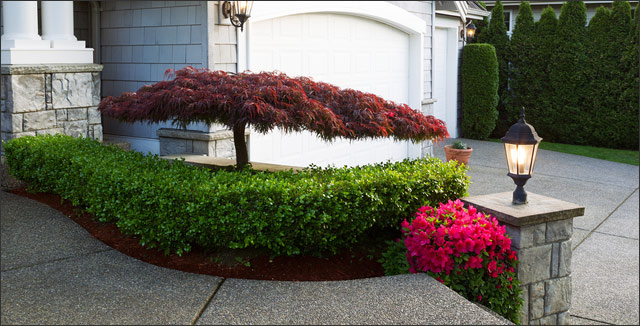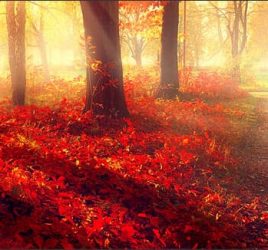Buying, Planting and Caring for Japanese Maple Trees

Whether it’s the unique shape or stunning color of each leaf, you might have hard time finding a more breathtaking and elegant tree than the Japanese maple. These incredible trees can provide much needed shade for other plants, and bring a splash of color and texture to any landscape.
Especially during the fall, these amazing trees command attention as their leaves turn to bright crimsons, gold, and orange colors. Japanese maples are an ideal addition to any landscape. Many varieties are small enough to be grown in a container or as a bonsai providing flexibility that makes them great for both large and small landscapes.
Buying Japanese Maples
It can be an intimidating process to know what to look for when you are buying your first Japanese maple tree. When you are investing a lot of money into your landscape, you want to make sure you are buying the best plants. Here are a few tips and questions to ask when buying your tree.
- Buy your tree from a trust worthy source. There are a lot of mislabeled trees on the market, so trusting the source is a vital part of getting a strong and healthy tree.
- Find out the history of your tree. Knowing the history of your tree will give you a lot of information. You want to ask how old the tree is, how it was grown, and if it has ever been replanted or repotted. Ask if the tree started from cutting, seeds or grafted.
- Make sure to check to see if there is any damage to the tree.
- Check to see if there are a return policy. One of the most important parts of buying and transplanting a tree will be the stability of the root system. You will want to make sure that you are buying from a quality store that allows for the root systems to fully establish.
Location Location Location
After you buy your Japanese maple, you will want begin to add it to your landscape and you will want to keep a few things in mind. While once your tree is established there is little care, but knowing a few details will help to make sure that you have a flourishing tree.
Your location might be the most important decision you make with your Japanese maple tree. According to Japanese Maple Online, “Being successful with Japanese Maples is the same as being successful with real estate, it all depends on location, location, location.”
When planting your Japanese maple you want to keep in mind the location of the tree and depending on the climate that you live in will help to determine what might be best for your Japanese maple.
Typically, Japanese maples like afternoon shade. If you live in southern and warmer states, you might need to offer your Japanese maples mostly shade especially when the tree is young and vulnerable. A mature Japanese maple will do well in full sun in all areas except for extremely hot climates.
A landscape with large and established trees will be a perfect place for your Japanese maple. If you see the leaves scorching, it might be a sign that the tree is getting too much sun. If possible, you want to allow it to have some sun to help to keep the ideal foliage color.
When it comes to figuring out your garden and what is best for your Japanese maple, Wayside Garden gave some great advice. They said,
“If after a year or two your Japanese Maple does not seem to ideally situated in your garden, don’t be afraid to dig up it up and move it. Location is one of the most important factors in growing this tree successfully, so a bit of trial-and-error may be in order.”
Like in all things gardening, it’s about experimenting, learning and figuring out what will work best for your garden. With the Japanese maple being a forgiving tree, it might be the ideal one for you.
Planting Japanese Maple
After you have found your ideal location for your Japanese maple, you will want to begin to plant your tree. The best time for planting will be about 1 – 3 months before the first frost. That may be around early fall depending on where you live. This gives your plant the time to develop deep roots for the winter.
When preparing the soil, keep in mind that while a Japanese maple can thrive in most soils, it doesn’t like a highly alkaline soil. If you have this type of soil, you might want to keep your tree in a container. Prepare the soil with organic compost. You may want to continue to add compost throughout the spring and summer. A Japanese maple is a heavy feeder when they are young plants and the compost will add valuable nutrients and help hold in moisture.
A Japanese maple will need lots of water in the first few years. Like most plants, the roots do best when moist. Plan to water your tree about two times a week.
A great way to make sure your Japanese maple will flourish is by installing Rootwell Pro 318s around the base of the tree. This is a direct to root watering system that will water your Japanese maple directly into the roots and help a young tree thrive. In addition, adding a layer of mulch around the root system will help to trap the moisture into your tree and help it flourish.
Caring For Your Japanese Maple Tree
Once your Japanese maple is established there is very little care that you need to worry about. The spring time will be the most vulnerable time for your plant because of late frosts. If this happens, you can cover your tree to help protect it from the frost. This will particularly be important if you have a young, unestablished Japanese maple. In the winter, you will want to make sure that a heavy snow fall doesn’t break any of the branches.
Take Away
If you are planning to add a Japanese maple to your landscape, you are going to be thrilled. The tree is stunning in all its different forms all year long. You will not be disappointed.
We would love to hear from you. Do you have a Japanese maple in your garden? Do you have any recommendations on favorite places to buy trees?

